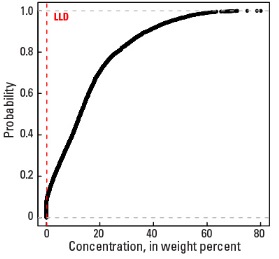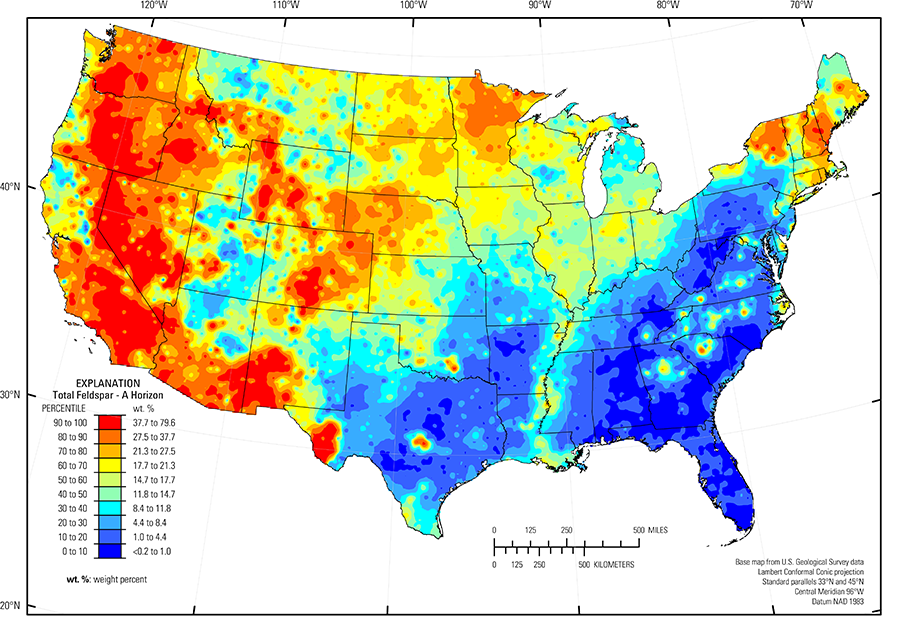
The purpose of these interpretive discussions is to provide a perspective on regional- and national-scale variations in element and mineral distributions in soils and their likely causes. The significant spatial variations shown by most elements and minerals can commonly be attributed to geologic sources in underlying parent materials, but other spatial variations seem clearly related to additional factors such as climate, the age of soils, transported source material, and anthropogenic influences. We attempt to distinguish the influence of these various factors on a regional and national scale. Numerous more local features might similarly be related to these same factors, but these features also have some probability of being an artifact of a random sampling of variable compositions, so that there is some probability of samples with similar compositions occurring in clusters of two or more adjacent sites by chance. Distinguishing such random occurrences from true variability is beyond the scope of the data from which these maps are constructed. Some caution, therefore, is advisable in interpreting the significance of these more local features unless some unique sources or processes can clearly be related to them.
Feldspars are aluminosilicate minerals containing varying amounts of calcium (Ca), potassium (K), or sodium (Na). The maps of total feldspar concentration are the sum of the individual maps of total potassium feldspar (K–rich) and plagioclase (Ca– and/or Na–rich). Feldspar is the most abundant mineral in igneous rocks and can be an important constituent of sedimentary rocks, alluvium, and eolian deposits derived from feldspar–bearing rocks. Feldspars are nearly ubiquitous across the United States but have a very wide range in concentrations. Feldspar in soil is highly susceptible to weathering in warm, humid climates, and so the maps for total feldspar reflect not only soil parent materials but also climatic conditions. Because feldspars are common in many soils and are subject to weathering, they represent significant stores of macronutrients K and Ca. Feldspars are detected in 94 percent of samples from the soil A horizon and 92 percent of samples from the soil C horizon. Median concentrations are 14.7 weight percent (wt. %) for the soil A horizon and 12.7 wt. % for the soil C horizon (see the summary statistics [open in new window]).
Feldspar is used in both the glassmaking and ceramic industries. The distribution of mineral resource deposits with feldspar as a commodity (major or minor) in the United States, extracted from the U.S. Geological Survey (USGS) Mineral Resource Data System (MRDS) website, can be seen by hovering the mouse here. Statistics and information on the worldwide supply of, demand for, and flow of feldspar are available through the USGS National Minerals Information Center (NMIC) website.
Plagioclase and potassium feldspar can occur together in many rock types, but also have disparate occurrences. Plagioclase is most abundant in mafic and intermediate volcanic and intrusive rocks, such as basalt or gabbro. Potassium feldspar is more commonly present in more silica–rich rocks, such as rhyolite and granite. The total feldspar maps blur this distinction between soil parent materials. For example, plagioclase (but not potassium feldspar) occurs in soils where parent materials include mafic and intermediate igneous rocks, such as the Pacific Northwest, which includes the Columbia River basalts (Swanson and Wright, 1981) and the basalts and andesites of the Cascade Range. In contrast, potassium feldspar is more abundant than plagioclase in soils developed from granitic soil parent materials, such as the Adirondack highlands (Fenneman and Johnson, 1946), in northern New York and in areas where potassium feldspar occurs in soils developed on eolian deposits sourced from granitic rocks, such as the Colorado Piedmont (Fenneman and Johnson, 1946).
The concentration and distribution of total feldspar are best explained in the detailed discussions of the two feldspar minerals. The plagioclase and potassium feldspar maps, and thus the maps for total feldspar, consistently show that soil in some areas of the conterminous United States have little or no feldspar because of an absence of original feldspar in parent material, such as the Texas carbonate terrane, or areas where intense weathering has destroyed all feldspars, such as many parts of the Piedmont (Fenneman and Johnson, 1946).
Statistics - 0 TO 5 CM
Statistics - A Horizon
| Number of samples | 4,802 |
| LLD | 0.2 wt. % |
| Number below LLD | 298 |
| Minimum | <0.2 wt. % |
| 5 percentile | <0.2 wt. % |
| 25 percentile | 6.4 wt. % |
| 50 percentile | 14.7 wt. % |
| 75 percentile | 24.1 wt. % |
| 95 percentile | 46.3 wt. % |
| Maximum | 79.6 wt. % |
| MAD | |
| Robust CV |
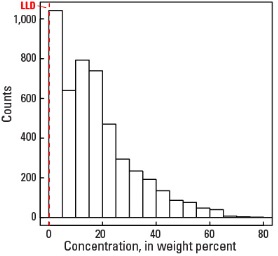
Histogram
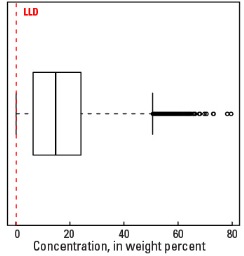
Boxplot

Empirical cumulative distribution function
Statistics - C Horizon
| Number of samples | 4,773 |
| LLD | 0.2 wt. % |
| Number below LLD | 390 |
| Minimum | <0.2 wt. % |
| 5 percentile | <0.2 wt. % |
| 25 percentile | 4.7 wt. % |
| 50 percentile | 12.7 wt. % |
| 75 percentile | 22.4 wt. % |
| 95 percentile | 46.6 wt. % |
| Maximum | 80.1 wt. % |
| MAD | |
| Robust CV |
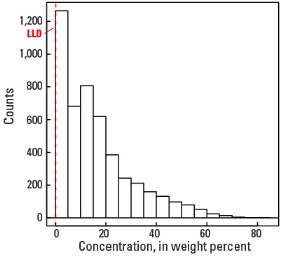
Histogram
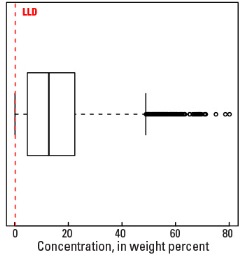
Boxplot
